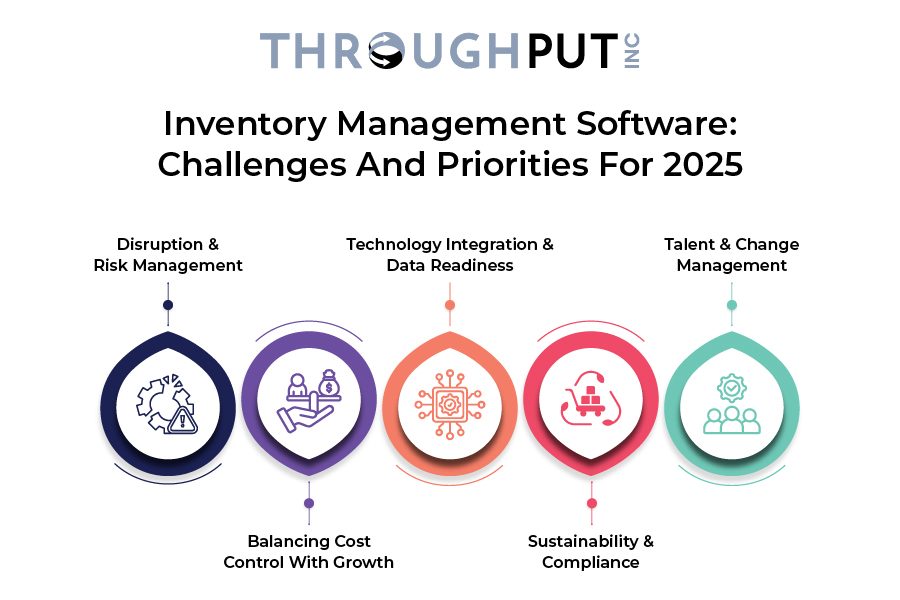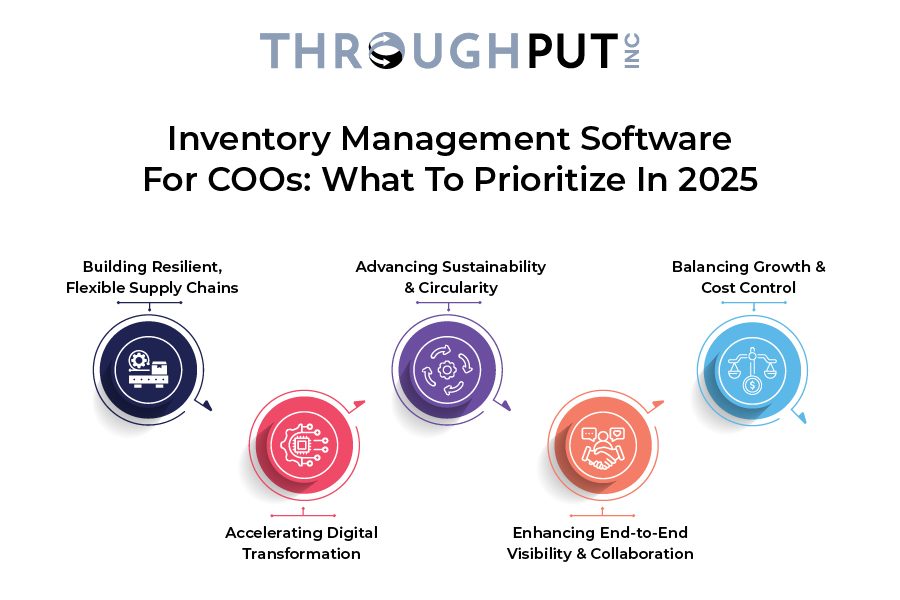In 2025, the Chief Operating Officer (COO) is no longer just the steward of operations—they are the architect of resilience, agility, and growth in a world where supply chain disruption is the norm. Leveraging powerful tools like Inventory Management Software, today’s COOs gain real-time visibility, streamline operations, and make faster, smarter decisions that keep their businesses ahead of constant change. As global volatility, digital acceleration, and rising customer expectations redefine the rules, COOs must orchestrate every moving part of the supply chain with precision and foresight. At the heart of this transformation is inventory management software, a strategic lever that empowers COOs to turn complexity into competitive advantage.
The Evolving Role of the COO in Supply Chain
From Operations to Strategy
Traditionally, COOs focused on ensuring efficient processes, overseeing manufacturing, logistics, and administrative functions. Today, their remit has expanded dramatically. Modern COOs translate the CEO’s vision into actionable operational strategies, integrate end-to-end supply chain processes, and drive cross-departmental collaboration. They are now pivotal in aligning internal operations with external market realities, customer expectations, and sustainability targets.
Key Responsibilities:
- Oversee the entire supply chain to maximize efficiency and avoid cost overruns.
- Develop and execute operational strategies that align with corporate objectives.
- Integrate logistics, procurement, manufacturing, and distribution for seamless delivery.
- Champion technology adoption, automation, and data-driven decision-making.
- Foster continuous improvement and innovation across teams and processes.
The Shifting Landscape: Challenges and Priorities for 2025

1. Disruption and Risk Management
Disruption is now a constant-geopolitical tensions, trade wars, regulatory shifts, extreme weather, and pandemics expose vulnerabilities in global supply chains. Nearly 47% of global supply chain executives see their organizations as vulnerable to disruption. COOs must build resilience through supplier diversification, nearshoring, and flexible sourcing strategies.
2. Balancing Cost Control with Growth
COOs face relentless pressure to drive growth while maintaining rigorous cost controls. The challenge is to rationalize complexity-distinguishing between value-adding activities and unnecessary overhead-while investing in capabilities that support both efficiency and expansion.
3. Technology Integration and Data Readiness
The digital revolution has made technology adoption a top priority, but many organizations struggle with data readiness. Integrating AI, IoT, and automation can unlock new efficiencies, but poor data quality and siloed systems often undermine these efforts. According to recent studies, poor data quality costs organizations an average of $12.9 million annually.
4. Sustainability and Compliance
Sustainability is now a strategic imperative. COOs are tasked with advancing circularity, reducing emissions, and ensuring regulatory compliance throughout the supply chain. This requires integrating environmental, social, and governance (ESG) considerations into operational decision-making.
5. Talent and Change Management
The pace of change in supply chain operations demands new skills and mindsets. COOs must lead workforce transformation, upskilling teams to leverage new technologies, and fostering a culture of innovation and agility.
What Should COOs Focus On in 2025?

1. Building Resilient, Flexible Supply Chains
- Diversify suppliers and manufacturing locations to mitigate risk.
- Develop contingency plans and crisis management protocols for rapid response to disruptions.
- Invest in scenario analysis and ecosystem collaboration to anticipate and adapt to geopolitical shifts.
2. Accelerating Digital Transformation
- Implement AI and automation to improve forecasting, inventory management, and logistics optimization.
- Prioritize data integration and readiness; establish clear KPIs and data governance frameworks.
- Encourage experimentation with new technologies and develop future-focused operational metrics.
3. Advancing Sustainability and Circularity
- Embed sustainability into procurement, production, and distribution strategies.
- Track and report on ESG metrics to meet regulatory and stakeholder expectations.
4. Enhancing End-to-End Visibility and Collaboration
- Break down silos between departments and functions to enable real-time decision-making.
- Use advanced analytics and dashboards to monitor performance and identify bottlenecks.
5. Balancing Growth and Cost Control
- Rationalize supply chain complexity to support business growth without excessive cost.
- Align operational investments with the company’s value proposition and long-term strategy.
Data Readiness: The Persistent Hurdle
Despite widespread technology adoption, data readiness remains a significant barrier. Many companies rush to implement AI and analytics without first addressing data quality, leading to suboptimal outcomes or even negative business impacts. Real-time, accurate, and integrated data is now essential for effective inventory management, demand forecasting, and operational decision-making.
What COOs Can Do Differently:
- Set a Clear Data Strategy: Define KPIs that balance inventory availability with cost efficiency, and establish transparent trade-offs.
- Invest in Data Integration: Prioritize solutions that work with existing data and systems, reducing silos and manual intervention.
- Leverage AI for Real-Time Insights: Use AI-driven platforms to validate, cleanse, and analyze data, enabling proactive rather than reactive decision-making.
Inventory Management Software: The COO’s Strategic Lever
ThroughPut AI: Transforming Inventory Management
Overview and Features
ThroughPut AI is a leading inventory management software solution, designed to deliver real-time control and operational spend management. Its advanced, patented algorithms offer:
- Demand-driven replenishment planning at the SKU level
- Dynamic lead time management for agile response to market changes
- Predictive analytics for order cancellation and supplier risk
- Real-time buffer management to avoid stockouts and overstock
- Granular visibility into inventory by location, SKU, and product portfolio
- Optimization of operational capital spend for maximum ROI
How It Works
ThroughPut AI integrates with existing data sources, providing actionable recommendations and visibility across the supply chain. Its AI-driven insights help COOs make business-critical decisions faster, with measurable financial impact and ROI typically realized within 90 days.

Real-World Impact: Case Studies
Coffee Retail Chain: Inventory Reduction & Productivity Gains
Challenge: A leading European coffee retail chain faced persistent inventory pile-ups, wastage, and poor SKU visibility, impacting cash flow and labor productivity.
Solution: ThroughPut AI’s inventory optimization module was deployed to analyze historical sales and turnover data, optimize product mix, and provide SKU-level visibility.
Impact:
- 5% reduction in inventory
- 5% increase in labor productivity
- Enhanced cash flow by prioritizing high-demand products and phasing out underperformers
Food Chain: Demand Sensing & Waste Reduction
Challenge: A food chain struggled with overstock, wastage, and inefficient sourcing due to lack of real-time demand sensing.
Solution: ThroughPut AI enabled near-term demand forecasting, dynamic lead time management, and smarter sourcing decisions.
Impact:
- Reduced overstock and food wastage
- Optimized raw material shipments
- Improved supplier risk management
Specific Benefits for COOs
| COO Challenge | ThroughPut AI Solution | Benefit |
| Cost Pressure | Operational capital optimization | Lower inventory holding costs |
| Bottleneck Identification | Real-time buffer and bottleneck alerts | Faster resolution, reduced downtime |
| Data Readiness | Works with existing data, AI cleansing | Unlocks value from current investments |
| Supplier Performance | Supplier risk management | Improved on-time, in-full deliveries |
| Agility & Innovation | Dynamic lead time & demand planning | Rapid response to market changes |
| Visibility | SKU-level, location-level dashboards | End-to-end transparency |
Conclusion: The COO’s Playbook for 2025
The modern COO must navigate a landscape defined by volatility, complexity, and relentless cost pressure. Inventory management software like ThroughPut AI is not just a tool, but a strategic lever-enabling COOs to maximize existing technology investments, drive operational excellence, and build resilient, data-driven supply chains.
Key Takeaways:
- Prioritize data readiness and integration to unlock the full value of digital investments.
- Leverage AI-powered inventory management for real-time visibility, predictive insights, and agile decision-making.
- Focus on solutions that deliver measurable ROI and can adapt to evolving business needs.
With the right inventory management software, COOs can transform challenges into opportunities-delivering not just efficiency, but true competitive differentiation in the supply chain.

FAQ:
1. Why is inventory management software critical for COOs in 2025?
In 2025, COOs are expected to drive resilience, efficiency, and innovation across supply chains. Inventory management software provides real-time visibility, predictive insights, and AI-driven recommendations, enabling COOs to reduce costs, improve service levels, and make agile decisions in a volatile global environment.
2. How does inventory management software help manage supply chain disruptions?
By offering predictive analytics and scenario modeling, inventory management software enables COOs to identify potential bottlenecks, anticipate demand fluctuations, and build more resilient sourcing and fulfillment strategies—essential for navigating disruptions like geopolitical shifts or raw material shortages.
3. What features should COOs look for in inventory management software?
Key features include real-time visibility into inventory levels, demand-driven replenishment, predictive analytics, integration with existing systems, and supplier risk management tools. AI-powered platforms like ThroughPut AI also offer dynamic lead time management and granular SKU-level insights.
4. How does ThroughPut AI support operational cost reduction?
ThroughPut AI optimizes inventory levels to avoid overstock and understock situations, reduces holding costs, and streamlines procurement and production planning. This leads to enhanced cash flow and a more efficient allocation of operational capital.
5. Can inventory management software help meet sustainability goals?
Yes. Efficient inventory management reduces waste, minimizes overproduction, and improves transportation efficiency—key components of a sustainable supply chain. Solutions like ThroughPut AI also help track ESG metrics and align operations with sustainability mandates.
6. What’s the ROI timeline for implementing inventory management software?
Platforms like ThroughPut AI typically deliver measurable ROI within 90 days. This includes improvements in inventory turnover, productivity, and cost efficiency—making it a strategic, high-impact investment for COOs.
7. How does inventory software improve collaboration across departments?
By breaking down data silos and providing centralized, real-time dashboards, inventory management software ensures better communication and coordination between procurement, logistics, finance, and operations teams—leading to more cohesive decision-making.
8. What if my company’s data is not clean or well-organized?
Modern inventory solutions like ThroughPut AI are designed to work with your existing data infrastructure. They use AI-driven data cleansing and integration to make sense of messy, siloed data and still deliver actionable insights without requiring a full system overhaul.
9. How does inventory software contribute to demand forecasting?
Inventory software leverages historical data, market signals, and real-time trends to create accurate, dynamic forecasts. This enables more precise replenishment planning, better supplier coordination, and smarter production schedules.
10. Is inventory management software only useful for large enterprises?
No. While enterprise-scale organizations benefit greatly, mid-sized companies can also gain significant operational and financial advantages. Scalable platforms like ThroughPut AI adapt to a company’s size, data maturity, and specific supply chain challenges.


